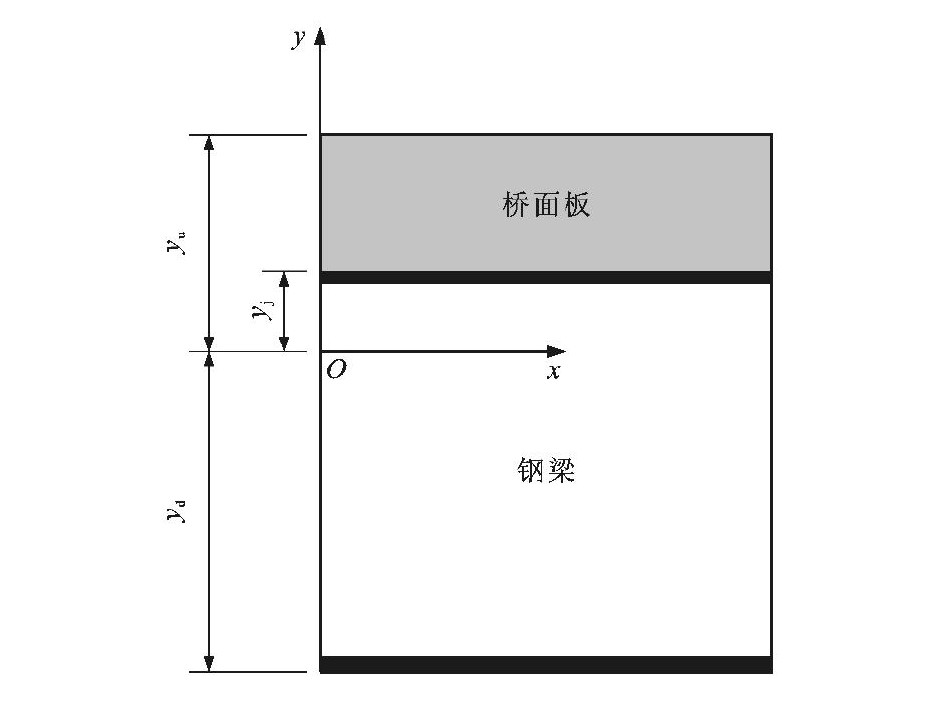Analytical solution of temperature effects of steel-concrete composite girder
Article Text (Baidu Translation)
-
摘要: 针对考虑和不考虑界面滑移2种情况, 在任意温度分布作用下, 推导了钢-混凝土组合梁界面剪力、相对滑移和温度应力理论计算公式, 采用有限元模拟对考虑界面滑移的公式进行了验证, 并在钢-混凝土温差模式(模式1)、《公路桥涵设计通用规范》 (JTG D60—2015) 温差模式(模式2) 和英国规范BS5400温差模式(模式3) 下, 对比了温度效应的计算结果。分析结果表明: 采用考虑界面滑移的剪力理论公式计算出的组合梁界面剪力分布与有限元计算结果规律一致, 3种模式下剪力最大偏差分别为1.15%、2.65%和3.41%;组合梁界面剪力服从双曲余弦函数分布, 界面滑移服从双曲正弦函数分布; 不考虑滑移与考虑滑移计算得到的界面最大剪力基本相等, 最大偏差仅为1.22%;组合梁跨中温度应力计算值的最大偏差小于1%, 但组合梁端部温度应力计算值偏差较大, 模式3温差为20℃时, 考虑滑移时的混凝土底部温度拉应力为不考虑滑移时的1.9倍; 组合梁的界面温度效应与温差成线性关系, 斜率与温度分布模式有关, 模式1的界面剪力、界面剪应力和界面滑移的变化速率最大, 分别为9.138kN·℃-1、0.067MPa·℃-1和5.263×10-3 mm·℃-1;温差为30℃时, 模式1的界面剪力、界面剪应力和界面滑移变化速率均为模式3的3倍以上, 因此, 不考虑钢梁温度梯度会使组合梁界面剪力、相对滑移与温度应力计算结果产生偏差, 且偏差会随温差的增大而增大。Abstract: Under the two cases of considering interface slippage or not, the theoretical calculation formulas of steel-concrete composite girder's interface shear force, relative slippage and temperature stress were deduced under arbitrary temperature distribution. The formulas under considering interface slippage were verified by using the finite element simulation. Under the steel-concrete temperature difference pattern (pattern 1), the temperature difference pattern in General Specifications for Design of Highway Bridges and Culverts (JTG D60—2015) (pattern 2) and the temperature difference pattern in British Code BS5400 (pattern 3), the calculation results of temperature effects were compared. Analysis result shows that the interface shear forcedistribution of composite girder calculated by the shear force theoretical formula under considering interface slippage has the same rule with the finite element calculation result, and the maximum shear force deviations under the 3 patterns are 1.15%, 2.65% and 3.41%, respectively. The interface shear force of composite girder obeys hyperbolic cosine function distribution, and the interface slippage obeys hyperbolic sine function distribution. The calculated shear forces under considering interface slippage or not are almost equal, and the maximum deviation is only 1.22%. The maximum deviation of calculated mid-span temperature stress of composite girder is less than 1%. However, the deviation of calculated temperature stress at the end of composite girder is larger. When the temperature difference is 20 ℃ in pattern 3, the temperature tensile stress at concrete slab bottom under considering the slippage is 1.9 times as large as the one under no considering the slippage. The interface temperature effect of composite girder has linear relationship with temperature difference, and its slope is related to the pattern of temperature distribution. The variation rates of interface shear force, interface shear stress and interface slippage are largest in pattern 1, and are 9.138 kN·℃-1, 0.067 MPa·℃-1 and 5.263×10-3 mm·℃-1, respectively. When the temperature difference is 30 ℃, the variation rates of interface shear force, interface shear stress and interface slippage in pattern 1 are more than 3 times as large as the values in pattern 3. Therefore, no considering the temperature gradient of steel girder can cause the deviations of interface force, relative slippage and temperature stress, and the deviations grow with the increase of temperature difference.
-
表 1 组合梁温度效应主要计算结果Fig.1 Main calculated results of composite girder's thermal effects

-
[1] 聂建国, 余志武. 钢-混凝土组合梁在我国的研究及应用[J]. 土木工程学报, 1999, 32 (2): 3-8. doi: 10.3321/j.issn:1000-131X.1999.02.001NIE Jian-guo, YU Zhi-wu. Research and practice of composite steel-concrete beams in China[J]. China Civil Engineering Journal, 1999, 32 (2): 3-8. (in Chinese). doi: 10.3321/j.issn:1000-131X.1999.02.001 [2] 刘永健, 高诣民, 周绪红, 等. 中小跨径钢-混凝土组合梁桥技术经济性分析[J]. 中国公路学报, 2017, 30 (3): 1-13. doi: 10.3969/j.issn.1001-7372.2017.03.001LIU Yong-jian, GAO Yi-min, ZHOU Xu-hong, et al. Technical and economic analysis in steel-concrete composite girder bridges with small and medium span[J]. China Journal of Highway and Transport, 2017, 30 (3): 1-13. (in Chinese). doi: 10.3969/j.issn.1001-7372.2017.03.001 [3] BERWANGER C, SYMKO Y. Thermal stresses in steelconcrete composite bridges[J]. Canadian Journal of Civil Engineering, 1975, 2 (1): 66-84. doi: 10.1139/l75-007 [4] CHAN M Y T, BEAUCHAMP J C, CHEUNG M S, et al. Thermal stresses in composite box-girder bridges[C]∥Canadian Society for Civil Engineering. Third International Conference on Short and Medium Span Bridges. Toronto: Canadian Society for Civil Engineering, 1990: 355-366. [5] CHANG S P, IM C K. Thermal behaviour of composite box girder bridges[J]. Proceedings of the Institution of Civil Engineers: Structures and Buildings, 2000, 140 (2): 117-126. doi: 10.1680/stbu.2000.140.2.117 [6] DILGER W H, GHALI A, CHAN M, et al. Temperature stresses in composite box girder bridges[J]. Journal of Structural Engineering, 1983, 109 (6): 1460-1478. doi: 10.1061/(ASCE)0733-9445(1983)109:6(1460) [7] PRIESTLEY M J. Thermal gradients in bridges-some design considerations[J]. New Zealand Engineering, 1972, 27 (7): 228-233. [8] ELBADRY M M, GHALI A. Temperature variations in concrete bridges[J]. Journal of Structural Engineering, 1983, 109 (10): 2355-2374. doi: 10.1061/(ASCE)0733-9445(1983)109:10(2355) [9] ELBADRY M M, GHALI A. Nonlinear temperature distribution and its effects on bridges[J]. IABSE Proceedings, 1983, 66: 169-191. [10] 刘兴法. 预应力混凝土箱梁温度应力计算方法[J]. 土木工程学报, 1986, 19 (1): 46-54. https://www.cnki.com.cn/Article/CJFDTOTAL-TMGC198601005.htmLIU Xing-fa. Computation of temperature stresses for prestressed concrete box girders[J]. China Civil Engineering Journal, 1986, 19 (1): 46-54. (in Chinese). https://www.cnki.com.cn/Article/CJFDTOTAL-TMGC198601005.htm [11] 张元海, 李乔. 桥梁结构日照温差二次力及温度应力计算方法研究[J]. 中国公路学报, 2004, 17 (1): 49-52. doi: 10.3321/j.issn:1001-7372.2004.01.011ZHANG Yuan-hai, LI Qiao. Study of the method for calculation of the thermal stress and secondary force of bridge structure by solar radiation[J]. China Journal of Highway and Transport, 2004, 17 (1): 49-52. (in Chinese). doi: 10.3321/j.issn:1001-7372.2004.01.011 [12] 张元海, 李乔. 预应力混凝土连续箱梁桥的温度应力分析[J]. 土木工程学报, 2006, 39 (3): 98-102. doi: 10.3321/j.issn:1000-131X.2006.03.015ZHANG Yuan-hai, LI Qiao. Analysis of thermal stress for prestressed concrete continuous box-girder bridges[J]. China Civil Engineering Journal, 2006, 39 (3): 98-102. (in Chinese). doi: 10.3321/j.issn:1000-131X.2006.03.015 [13] 彭友松, 强士中. 混凝土桥梁结构温度自应力计算方法探讨[J]. 西南交通大学学报, 2006, 41 (4): 452-455. doi: 10.3969/j.issn.0258-2724.2006.04.010PENG You-song, QIANG Shi-zhong. Investigation into computational method of self-equilibrating thermal stresses in concrete bridges[J]. Journal of Southwest Jiaotong University, 2006, 41 (4): 452-455. (in Chinese). doi: 10.3969/j.issn.0258-2724.2006.04.010 [14] 彭友松, 强士中. 公路混凝土箱梁三维温度应力计算方法[J]. 交通运输工程学报, 2007, 7 (1): 63-67. doi: 10.3321/j.issn:1671-1637.2007.01.014PENG You-song, QIANG Shi-zhong. 3-D thermal stress computation method of highway concrete box-girder[J]. Journal of Traffic and Transportation Engineering, 2007, 7 (1): 63-67. (in Chinese). doi: 10.3321/j.issn:1671-1637.2007.01.014 [15] 彭友松, 朱晓文, 强士中. 混凝土箱梁温度应力三维分析[J]. 铁道学报, 2009, 31 (3): 116-121. doi: 10.3969/j.issn.1001-8360.2009.03.021PENG You-song, ZHU Xiao-wen, QIANG Shi-zhong. Three dimensional analyses of thermal stresses in concrete boxgirders[J]. Journal of the China Railway Society, 2009, 31 (3): 116-121. (in Chinese). doi: 10.3969/j.issn.1001-8360.2009.03.021 [16] 颜昌清, 阳先全. 混凝土薄壁箱梁横向温度应力分析[J]. 桥梁建设, 2009 (3): 25-28. https://www.cnki.com.cn/Article/CJFDTOTAL-QLJS200903005.htmYAN Chang-qing, YANG Xian-quan. Analysis of transverse temperature stress of concrete thin-wall box girder[J]. Bridge Construction, 2009 (3): 25-28. (in Chinese). https://www.cnki.com.cn/Article/CJFDTOTAL-QLJS200903005.htm [17] 任翔, 黄平明, 韩万水. 混凝土薄壁箱形结构横向温度应力解析计算方法[J]. 中国公路学报, 2012, 25 (1): 76-82. doi: 10.3969/j.issn.1001-7372.2012.01.012REN Xiang, HUANG Ping-ming, HAN Wan-shui. Transverse temperature stress computation method of concrete thin-wall box-shape structure[J]. China Journal of Highway and Transport, 2012, 25 (1): 76-82. (in Chinese). doi: 10.3969/j.issn.1001-7372.2012.01.012 [18] 陈彦江, 王力波, 李勇. 钢-混凝土组合梁桥温度场及温度效应研究[J]. 公路交通科技, 2014, 31 (11): 85-91. doi: 10.3969/j.issn.1002-0268.2014.11.014CHEN Yan-jiang, WANG Li-bo, LI Yong. Research of temperature field and its effect of steel-concrete composite girder bridge[J]. Journal of Highway and Transportation Research and Development, 2014, 31 (11): 85-91. (in Chinese). doi: 10.3969/j.issn.1002-0268.2014.11.014 [19] 刘瑜, 邵旭东. 轻型组合梁桥面板在日照作用下温度梯度效应研究[J]. 公路交通科技, 2015, 32 (6): 54-61. doi: 10.3969/j.issn.1002-0268.2015.06.009LIU Yu, SHAO Xu-dong. Research on temperature gradient effect of light-weighted composite bridge deck under solar radiation[J]. Journal of Highway and Transportation Research and Development, 2015, 32 (6): 54-61. (in Chinese). doi: 10.3969/j.issn.1002-0268.2015.06.009 [20] 卢磊. 基于ABAQUS钢—混凝土组合梁温度应力研究[D]. 西安: 长安大学, 2015.LU Lei. Study on temperature stress of steel and concrete composite beams based ABAQUS[D]. Xi'an: Chang'an University, 2015. (in Chinese). [21] 王达, 张永健, 刘扬, 等. 基于健康监测的钢桁加劲梁钢-混组合桥面系竖向温度梯度效应分析[J]. 中国公路学报, 2015, 28 (11): 29-36. https://www.cnki.com.cn/Article/CJFDTOTAL-ZGGL201511006.htmWANG Da, ZHANG Yong-jian, LIU Yang, et al. Vertical temperature gradient effect analysis of steel-concrete composite deck system on steel truss stiffening girder with health monitoring[J]. China Journal of Highway and Transport, 2015, 28 (11): 29-36. (in Chinese). https://www.cnki.com.cn/Article/CJFDTOTAL-ZGGL201511006.htm [22] 王达, 王海柱, 刘扬. 中、美、欧标准中钢-混组合结构桥面系竖向温度梯度效应的比较[J]. 工业建筑, 2016, 46 (10): 163-168, 173. https://www.cnki.com.cn/Article/CJFDTOTAL-GYJZ201610033.htmWANG Da, WANG Hai-zhu, LIU Yang. In comparison with vertical temperature gradient effects of steel-concrete composite bridge deck in Chinese, American and EU codes[J]. Industrial Construction, 2016, 46 (10): 163-168, 173. (in Chinese). https://www.cnki.com.cn/Article/CJFDTOTAL-GYJZ201610033.htm [23] 张烈. 钢-混凝土组合梁桥早期温度效应试验研究[J]. 公路交通科技: 应用技术版, 2017 (2): 153-156.ZHANG Lie. Experimental study on steel-concrete composite girder thermal effect in early age[J]. Journal of Highway and Transportation Research and Development: Application and Technology, 2017 (2): 153-156. (in Chinese). [24] 陈玉骥, 叶梅新. 钢-混凝土结合梁在温度作用下的响应分析[J]. 中国铁道科学, 2001, 22 (5): 48-53. https://www.cnki.com.cn/Article/CJFDTOTAL-ZGTK200105008.htmCHEN Yu-ji, YE Mei-xin. Analyses of responses of composite girders under the action of temperature[J]. China Railway Science, 2001, 22 (5): 48-53. (in Chinese). https://www.cnki.com.cn/Article/CJFDTOTAL-ZGTK200105008.htm [25] 陈玉骥, 叶梅新. 钢-混凝土连续结合梁的温度效应[J]. 中南大学学报: 自然科学版, 2004, 35 (1): 142-146. https://www.cnki.com.cn/Article/CJFDTOTAL-ZNGD200401028.htmCHEN Yu-ji, YE Mei-xin. Temperature responses of steelconcrete continuous composite girders[J]. Journal of Central South University: Natural Science, 2004, 35 (1): 142-146. (in Chinese). https://www.cnki.com.cn/Article/CJFDTOTAL-ZNGD200401028.htm [26] 周良, 陆元春, 李雪峰. 钢-混凝土组合梁的温度应力计算[J]. 公路交通科技, 2012, 29 (5): 83-88. https://www.cnki.com.cn/Article/CJFDTOTAL-GLJK201205013.htmZHOU Liang, LU Yuan-chun, LI Xue-feng. Calculation of temperature stress of steel-concrete composite beam[J]. Journal of Highway and Transportation Research and Development, 2012, 29 (5): 83-88. (in Chinese). https://www.cnki.com.cn/Article/CJFDTOTAL-GLJK201205013.htm [27] 周勇超, 胡圣能, 宋磊, 等. 钢-混凝土组合梁的温度骤变效应分析[J]. 交通运输工程学报, 2013, 13 (1): 20-26. http://transport.chd.edu.cn/article/id/201301004ZHOU Yong-chao, HU Sheng-neng, SONG Lei, et al. Effect analysis of steel-concrete composite beam caused by sudden change of temperature[J]. Journal of Traffic and Transportation Engineering, 2013, 13 (1): 20-26. (in Chinese). http://transport.chd.edu.cn/article/id/201301004 [28] 阴存欣. 钢-混组合梁温度及收缩效应分析的电算方法[J]. 中国公路学报, 2014, 27 (11): 76-83. https://www.cnki.com.cn/Article/CJFDTOTAL-ZGGL201411014.htmYIN Cun-xin. Computing method for effect analysis of temperature and shrinkage on steel-concrete composite beams[J]. China Journal of Highway and Transport, 2014, 27 (11): 76-83. (in Chinese). https://www.cnki.com.cn/Article/CJFDTOTAL-ZGGL201411014.htm [29] 吴迅, 陈经伟, 肖春, 等. 温差、收缩引起的钢-混凝土组合梁界面处剪力作用研究[J]. 结构工程师, 2009, 25 (1): 41-44, 54. https://www.cnki.com.cn/Article/CJFDTOTAL-JGGC200901010.htmWU Xun, CHEN Jing-wei, XIAO Chun, et al. Study on shear effect caused by temperature and shrinkage on the interface of steel-concrete composite beams[J]. Structural Engineers, 2009, 25 (1): 41-44, 54. (in Chinese). https://www.cnki.com.cn/Article/CJFDTOTAL-JGGC200901010.htm [30] CHEN Quan. Effects of thermal loads on texas steel bridges[D]. Austin: University of Texas at Austin, 2008. [31] 孙国晨, 关荣财, 姜英民, 等. 钢-混凝土叠合梁横截面日照温度分布研究[J]. 工程力学, 2006, 23 (11): 122-127, 138. https://www.cnki.com.cn/Article/CJFDTOTAL-GCLX200611019.htmSUN Guo-chen, GUAN Rong-cai, JIANG Ying-min, et al. Sunshine-induced temperature distribution on cross section of steel-concrete composite beams[J]. Engineering Mechanics, 2006, 23 (11): 122-127, 138. (in Chinese). https://www.cnki.com.cn/Article/CJFDTOTAL-GCLX200611019.htm [32] AU F T K, CHEUNG S K, THAM L G. Design thermal loading for composite bridges in tropical region[J]. Steel and Composite Structures, 2002, 2 (6): 441-460. -





 下载:
下载:

















